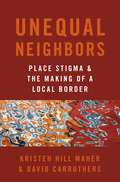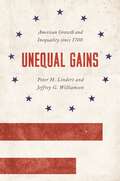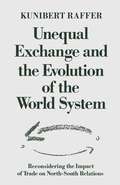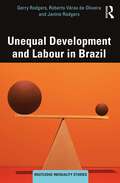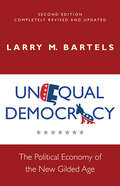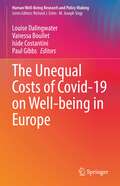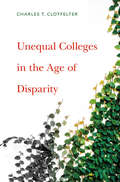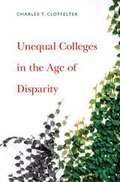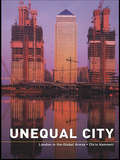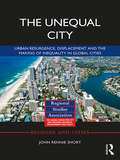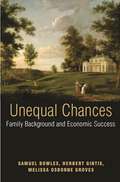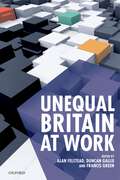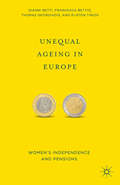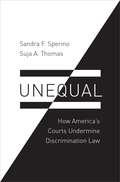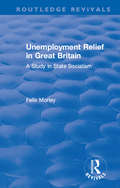- Table View
- List View
Unequal Neighbors: Place Stigma and the Making of a Local Border
by Kristen Hill Maher David CarruthersSan Diego and Tijuana are the site of a national border enforcement spectacle, but they are also neighboring cities with deeply intertwined histories, cultures, and economies. In Unequal Neighbors, Kristen Hill Maher and David Carruthers shift attention from the national border to a local one, examining the role of place stigma in reinforcing actual and imagined inequalities between these cities. Widespread "bordered imaginaries" in San Diego represent it as a place of economic vitality, safety, and order, while stigmatizing Tijuana as a zone of poverty, crime, and corruption. These dualisms misrepresent complex realities on the ground, but they also have real material effects: the vision of a local border benefits some actors in the region while undermining others. Based on a wide range of original empirical materials, the book examines how asymmetries between these cities have been produced and reinforced through stigmatizing representations of Tijuana in media, everyday talk, economic relations, and local tourism discourse and practices. However, both place stigma and borders are subject to contestation, and the book also examines "debordering" practices and counter-narratives about Tijuana's image. While the details of the book are particular to this corner of the world, the kinds of processes it documents offer a window into the making of unequal neighbors more broadly. The dynamics at the Tijuana border present a framework for understanding how inequalities that manifest in cultural practices produce asymmetric borders between places.
Unequal Gains: American Growth and Inequality since 1700
by Peter H. Lindert Jeffrey G. WilliamsonUnequal Gains offers a radically new understanding of the economic evolution of the United States, providing a complete picture of the uneven progress of America from colonial times to today.While other economic historians base their accounts on American wealth, Peter Lindert and Jeffrey Williamson focus instead on income—and the result is a bold reassessment of the American economic experience. America has been exceptional in its rising inequality after an egalitarian start, but not in its long-run growth.America had already achieved world income leadership by 1700, not just in the twentieth century as is commonly thought. Long before independence, American colonists enjoyed higher living standards than Britain—and America's income advantage today is no greater than it was three hundred years ago. But that advantage was lost during the Revolution, lost again during the Civil War, and lost a third time during the Great Depression, though it was regained after each crisis. In addition, Lindert and Williamson show how income inequality among Americans rose steeply in two great waves—from 1774 to 1860 and from the 1970s to today—rising more than in any other wealthy nation in the world. Unequal Gains also demonstrates how the widening income gaps have always touched every social group, from the richest to the poorest. The book sheds critical light on the forces that shaped American income history, and situates that history in a broad global context.Economic writing at its most stimulating, Unequal Gains provides a vitally needed perspective on who has benefited most from American growth, and why.
Unequal Gains: American Growth and Inequality since 1700
by Peter H. Lindert Jeffrey G. WilliamsonUnequal Gains offers a radically new understanding of the economic evolution of the United States, providing a complete picture of the uneven progress of America from colonial times to today.While other economic historians base their accounts on American wealth, Peter Lindert and Jeffrey Williamson focus instead on income—and the result is a bold reassessment of the American economic experience. America has been exceptional in its rising inequality after an egalitarian start, but not in its long-run growth.America had already achieved world income leadership by 1700, not just in the twentieth century as is commonly thought. Long before independence, American colonists enjoyed higher living standards than Britain—and America's income advantage today is no greater than it was three hundred years ago. But that advantage was lost during the Revolution, lost again during the Civil War, and lost a third time during the Great Depression, though it was regained after each crisis. In addition, Lindert and Williamson show how income inequality among Americans rose steeply in two great waves—from 1774 to 1860 and from the 1970s to today—rising more than in any other wealthy nation in the world. Unequal Gains also demonstrates how the widening income gaps have always touched every social group, from the richest to the poorest. The book sheds critical light on the forces that shaped American income history, and situates that history in a broad global context.Economic writing at its most stimulating, Unequal Gains provides a vitally needed perspective on who has benefited most from American growth, and why.
Unequal Gains: American Growth and Inequality since 1700 (The Princeton Economic History of the Western World #62)
by Peter H. Lindert Jeffrey G. WilliamsonA book that rewrites the history of American prosperity and inequalityUnequal Gains offers a radically new understanding of the economic evolution of the United States, providing a complete picture of the uneven progress of America from colonial times to today.While other economic historians base their accounts on American wealth, Peter Lindert and Jeffrey Williamson focus instead on income—and the result is a bold reassessment of the American economic experience. America has been exceptional in its rising inequality after an egalitarian start, but not in its long-run growth.America had already achieved world income leadership by 1700, not just in the twentieth century as is commonly thought. Long before independence, American colonists enjoyed higher living standards than Britain—and America's income advantage today is no greater than it was three hundred years ago. But that advantage was lost during the Revolution, lost again during the Civil War, and lost a third time during the Great Depression, though it was regained after each crisis. In addition, Lindert and Williamson show how income inequality among Americans rose steeply in two great waves—from 1774 to 1860 and from the 1970s to today—rising more than in any other wealthy nation in the world. Unequal Gains also demonstrates how the widening income gaps have always touched every social group, from the richest to the poorest. The book sheds critical light on the forces that shaped American income history, and situates that history in a broad global context.Economic writing at its most stimulating, Unequal Gains provides a vitally needed perspective on who has benefited most from American growth, and why.
Unequal Exchange and the Evolution of the World System: Reconsidering The Impact Of Trade On North-south Relations
by Kunibert RafferUnequal Development and Labour in Brazil (Routledge Inequality Studies)
by Gerry Rodgers Roberto Véras de Oliveira Janine RodgersThis book is about unequal development and labour in Brazil, with particular reference to the economic and social development of the Northeast region, which has suffered persistent disadvantage. It combines a historical approach, which shows how economic, social and political institutions have been restructured over time, with an analysis of changes in the pattern of production, employment, unemployment and inequality up to the present day. It draws on detailed case studies to examine the connections between local and national production systems and critical labour market outcomes such as informality in employment, precarious work and disparities between genders, races and regions. The case of the Brazilian Northeast illustrates processes, relationships and policy debates that are important not only in Brazil but also elsewhere. The book will be of interest to teachers, researchers and students in economics, sociology, labour and development; public officials and policy-makers; the international development community; and the general public interested in Latin American affairs. They will find in the book an original and systematic analysis of the factors underlying unequal development and how they respond to different policy regimes and suggestions about the issues that need to be addressed in the future.
Unequal Development and Labour in Brazil (Routledge Inequality Studies)
by Gerry Rodgers Roberto Véras de Oliveira Janine RodgersThis book is about unequal development and labour in Brazil, with particular reference to the economic and social development of the Northeast region, which has suffered persistent disadvantage. It combines a historical approach, which shows how economic, social and political institutions have been restructured over time, with an analysis of changes in the pattern of production, employment, unemployment and inequality up to the present day. It draws on detailed case studies to examine the connections between local and national production systems and critical labour market outcomes such as informality in employment, precarious work and disparities between genders, races and regions. The case of the Brazilian Northeast illustrates processes, relationships and policy debates that are important not only in Brazil but also elsewhere. The book will be of interest to teachers, researchers and students in economics, sociology, labour and development; public officials and policy-makers; the international development community; and the general public interested in Latin American affairs. They will find in the book an original and systematic analysis of the factors underlying unequal development and how they respond to different policy regimes and suggestions about the issues that need to be addressed in the future.
Unequal Democracy: The Political Economy of the New Gilded Age
by Larry M. BartelsThe first edition of Unequal Democracy was an instant classic, shattering illusions about American democracy and spurring scholarly and popular interest in the political causes and consequences of escalating economic inequality.This revised and expanded edition includes two new chapters on the political economy of the Obama era. One presents the Great Recession as a "stress test" of the American political system by analyzing the 2008 election and the impact of Barack Obama's “New New Deal” on the economic fortunes of the rich, middle class, and poor. The other assesses the politics of inequality in the wake of the Occupy Wall Street movement, the 2012 election, and the partisan gridlock of Obama’s second term. Larry Bartels offers a sobering account of the barriers to change posed by partisan ideologies and the political power of the wealthy. He also provides new analyses of tax policy, partisan differences in economic performance, the struggle to raise the minimum wage, and inequalities in congressional representation.President Obama identified inequality as “the defining challenge of our time.” Unequal Democracy is the definitive account of how and why our political system has failed to rise to that challenge. Now more than ever, this is a book every American needs to read.
Unequal Democracy: The Political Economy of the New Gilded Age
by Larry M. BartelsThe first edition of Unequal Democracy was an instant classic, shattering illusions about American democracy and spurring scholarly and popular interest in the political causes and consequences of escalating economic inequality.This revised and expanded edition includes two new chapters on the political economy of the Obama era. One presents the Great Recession as a "stress test" of the American political system by analyzing the 2008 election and the impact of Barack Obama's “New New Deal” on the economic fortunes of the rich, middle class, and poor. The other assesses the politics of inequality in the wake of the Occupy Wall Street movement, the 2012 election, and the partisan gridlock of Obama’s second term. Larry Bartels offers a sobering account of the barriers to change posed by partisan ideologies and the political power of the wealthy. He also provides new analyses of tax policy, partisan differences in economic performance, the struggle to raise the minimum wage, and inequalities in congressional representation.President Obama identified inequality as “the defining challenge of our time.” Unequal Democracy is the definitive account of how and why our political system has failed to rise to that challenge. Now more than ever, this is a book every American needs to read.
Unequal Democracy: The Political Economy of the New Gilded Age - Second Edition (Russell Sage Foundation Co-pub)
by Larry M. BartelsAn acclaimed examination of how the American political system favors the wealthy—now fully revised and expandedThe first edition of Unequal Democracy was an instant classic, shattering illusions about American democracy and spurring scholarly and popular interest in the political causes and consequences of escalating economic inequality. This revised, updated, and expanded second edition includes two new chapters on the political economy of the Obama era. One presents the Great Recession as a "stress test" of the American political system by analyzing the 2008 election and the impact of Barack Obama's "New New Deal" on the economic fortunes of the rich, middle class, and poor. The other assesses the politics of inequality in the wake of the Occupy Wall Street movement, the 2012 election, and the partisan gridlock of Obama’s second term. Larry Bartels offers a sobering account of the barriers to change posed by partisan ideologies and the political power of the wealthy. He also provides new analyses of tax policy, partisan differences in economic performance, the struggle to raise the minimum wage, and inequalities in congressional representation.President Obama identified inequality as "the defining challenge of our time." Unequal Democracy is the definitive account of how and why our political system has failed to rise to that challenge. Now more than ever, this is a book every American needs to read.
Unequal Democracy: The Political Economy of the New Gilded Age - Second Edition (Russell Sage Foundation Co-pub)
by Larry M. BartelsAn acclaimed examination of how the American political system favors the wealthy—now fully revised and expandedThe first edition of Unequal Democracy was an instant classic, shattering illusions about American democracy and spurring scholarly and popular interest in the political causes and consequences of escalating economic inequality. This revised, updated, and expanded second edition includes two new chapters on the political economy of the Obama era. One presents the Great Recession as a "stress test" of the American political system by analyzing the 2008 election and the impact of Barack Obama's "New New Deal" on the economic fortunes of the rich, middle class, and poor. The other assesses the politics of inequality in the wake of the Occupy Wall Street movement, the 2012 election, and the partisan gridlock of Obama’s second term. Larry Bartels offers a sobering account of the barriers to change posed by partisan ideologies and the political power of the wealthy. He also provides new analyses of tax policy, partisan differences in economic performance, the struggle to raise the minimum wage, and inequalities in congressional representation.President Obama identified inequality as "the defining challenge of our time." Unequal Democracy is the definitive account of how and why our political system has failed to rise to that challenge. Now more than ever, this is a book every American needs to read.
The Unequal Costs of Covid-19 on Well-being in Europe (Human Well-Being Research and Policy Making)
by Louise Dalingwater Vanessa Boullet Iside Costantini Paul GibbsThis volume focuses on the wider wellbeing costs within European countries as a result of the outbreak of the pandemic and the control measures implemented thereafter. In particular, it considers to what extent Covid-19 and measures taken to cope with the crisis have weakened economic and social structures across Europe and what effect this has had on people’s lives. While many countries in Europe have reallocated public funding to health care, provided support to SMEs, vulnerable populations and regions hit by the crisis, the wellbeing or welfare costs, considered broadly, are still significant. The authors' assessment thus goes beyond the subjective wellbeing discourse and evaluates to what extent structural weaknesses within economic, social and regional frameworks have deepened. The chapters discuss what policies are needed to address these weaknesses. the volume thus recognises that structural inequalities are a key driver of wellbeing. While there have been a number of publications on wellbeing during the pandemic, the original perspective in each chapter on inequalities and the European focus of this publication provide novel information and insights on the topic.
Unequal Colleges in the Age of Disparity
by Charles T. ClotfelterBased on quantitative comparisons of colleges since the 1970s, Charles Clotfelter reveals that despite the civil rights revolution, billions spent on financial aid, and the commitment of colleges to greater equality, stratification in higher education has grown starker. He explains why undergraduate education—unequal in 1970—is even more so today.
Unequal Colleges in the Age of Disparity
by Charles T. ClotfelterBased on quantitative comparisons of colleges since the 1970s, Charles Clotfelter reveals that despite the civil rights revolution, billions spent on financial aid, and the commitment of colleges to greater equality, stratification in higher education has grown starker. He explains why undergraduate education—unequal in 1970—is even more so today.
Unequal City: London in the Global Arena
by Chris HamnettUnequal City examines some of the dramatic economic and social changes that have taken place in London over the last forty years. It describes how London’s changing industrial structure, particularly the shift from an industrial—to a services-based city, and the associated changes in occupational class structure and in the structure of earnings and incomes, have worked through to the housing market and the gentrification of large parts in Inner London. This has had major consequences for both the social structure and the built environment of London. It asserts that this transformation in London’s industrial structure, from a city with a large manufacturing base to one based primarily on business, financial, creative and other services, is linked to a major change in its occupational structure. But, unlike much of the literature, which argues that cities like London have become increasingly socially polarised, it argues that London has become more professionalised and has a shrinking manual workforce. The changes in the industrial and occupational structure of London have been linked to changes in its earnings and income structures. The dominant feature of London has been an expansion of its high-earning groups and a marked increase in both earnings and income inequality. The growth of this expanded new middle class has had major impacts on the nature of the London housing market, particularly in the growth of home ownership, rising prices and the expansion of middle-class gentrification across much of Inner London. This has been paralleled by the growing marginalisation of the less skilled, the unemployed and various minority groups in the council sector. These changes have reshaped the social structure and social geography of London. They have made it a more unequal city. Unequal City relates to the literature on global cities. The book has a wide sweep and summarises a wide range of literature on occupational and industrial change, earnings and incomes and the housing market and gentrification. It provides a wealth of original data, figures, maps and tables and will be a valuable reference for anyone interested in the changes that have reshaped the social structure of London in recent decades.
Unequal City: London in the Global Arena (PDF)
by Chris HamnettUnequal City examines some of the dramatic economic and social changes that have taken place in London over the last forty years. It describes how London’s changing industrial structure, particularly the shift from an industrial—to a services-based city, and the associated changes in occupational class structure and in the structure of earnings and incomes, have worked through to the housing market and the gentrification of large parts in Inner London. This has had major consequences for both the social structure and the built environment of London. It asserts that this transformation in London’s industrial structure, from a city with a large manufacturing base to one based primarily on business, financial, creative and other services, is linked to a major change in its occupational structure. But, unlike much of the literature, which argues that cities like London have become increasingly socially polarised, it argues that London has become more professionalised and has a shrinking manual workforce. The changes in the industrial and occupational structure of London have been linked to changes in its earnings and income structures. The dominant feature of London has been an expansion of its high-earning groups and a marked increase in both earnings and income inequality. The growth of this expanded new middle class has had major impacts on the nature of the London housing market, particularly in the growth of home ownership, rising prices and the expansion of middle-class gentrification across much of Inner London. This has been paralleled by the growing marginalisation of the less skilled, the unemployed and various minority groups in the council sector. These changes have reshaped the social structure and social geography of London. They have made it a more unequal city. Unequal City relates to the literature on global cities. The book has a wide sweep and summarises a wide range of literature on occupational and industrial change, earnings and incomes and the housing market and gentrification. It provides a wealth of original data, figures, maps and tables and will be a valuable reference for anyone interested in the changes that have reshaped the social structure of London in recent decades.
The Unequal City: Urban Resurgence, Displacement and the Making of Inequality in Global Cities (Regions and Cities)
by John Rennie ShortCities around the world have seen: an increase in population and capital investments in land and building; a shift in central city populations as the poor are forced out; and a radical restructuring of urban space. The Unequal City tells the story of urban change and acts as a comprehensive guide to the Urban Now. A number of trends are examined, including: the role of liquid capital; the resurgence of population; the construction of megaprojects and hosting of global megaevents; the role of the new rich; and the emergence of a new middle class. This book explores the reasons behind the displacement of the poor to the suburbs and beyond. Drawing upon case studies from around the world, readers are exposed to an examination of the urban projects that involve the reuse of older industrial spaces, the greening of the cities, and the securitization of the public spaces. This book draws on political economy, cultural and political analysis, and urban geography approaches in order to consider the multifaceted nature of the process and its global unfolding. It will be essential reading to those interested in urban studies, economic geography, urban economics, urban sociology, urban planning and globalization.
The Unequal City: Urban Resurgence, Displacement and the Making of Inequality in Global Cities (Regions and Cities)
by John Rennie ShortCities around the world have seen: an increase in population and capital investments in land and building; a shift in central city populations as the poor are forced out; and a radical restructuring of urban space. The Unequal City tells the story of urban change and acts as a comprehensive guide to the Urban Now. A number of trends are examined, including: the role of liquid capital; the resurgence of population; the construction of megaprojects and hosting of global megaevents; the role of the new rich; and the emergence of a new middle class. This book explores the reasons behind the displacement of the poor to the suburbs and beyond. Drawing upon case studies from around the world, readers are exposed to an examination of the urban projects that involve the reuse of older industrial spaces, the greening of the cities, and the securitization of the public spaces. This book draws on political economy, cultural and political analysis, and urban geography approaches in order to consider the multifaceted nature of the process and its global unfolding. It will be essential reading to those interested in urban studies, economic geography, urban economics, urban sociology, urban planning and globalization.
Unequal Chances: Family Background and Economic Success
by Samuel Bowles Herbert Gintis Melissa Osborne GrovesIs the United States "the land of equal opportunity" or is the playing field tilted in favor of those whose parents are wealthy, well educated, and white? If family background is important in getting ahead, why? And if the processes that transmit economic status from parent to child are unfair, could public policy address the problem? Unequal Chances provides new answers to these questions by leading economists, sociologists, biologists, behavioral geneticists, and philosophers. New estimates show that intergenerational inequality in the United States is far greater than was previously thought. Moreover, while the inheritance of wealth and the better schooling typically enjoyed by the children of the well-to-do contribute to this process, these two standard explanations fail to explain the extent of intergenerational status transmission. The genetic inheritance of IQ is even less important. Instead, parent-offspring similarities in personality and behavior may play an important role. Race contributes to the process, and the intergenerational mobility patterns of African Americans and European Americans differ substantially. Following the editors' introduction are chapters by Greg Duncan, Ariel Kalil, Susan E. Mayer, Robin Tepper, and Monique R. Payne; Bhashkar Mazumder; David J. Harding, Christopher Jencks, Leonard M. Lopoo, and Susan E. Mayer; Anders Björklund, Markus Jäntti, and Gary Solon; Tom Hertz; John C. Loehlin; Melissa Osborne Groves; Marcus W. Feldman, Shuzhuo Li, Nan Li, Shripad Tuljapurkar, and Xiaoyi Jin; and Adam Swift.
Unequal Chances: Family Background and Economic Success
by Samuel Bowles Herbert Gintis Melissa Osborne GrovesIs the United States "the land of equal opportunity" or is the playing field tilted in favor of those whose parents are wealthy, well educated, and white? If family background is important in getting ahead, why? And if the processes that transmit economic status from parent to child are unfair, could public policy address the problem? Unequal Chances provides new answers to these questions by leading economists, sociologists, biologists, behavioral geneticists, and philosophers. New estimates show that intergenerational inequality in the United States is far greater than was previously thought. Moreover, while the inheritance of wealth and the better schooling typically enjoyed by the children of the well-to-do contribute to this process, these two standard explanations fail to explain the extent of intergenerational status transmission. The genetic inheritance of IQ is even less important. Instead, parent-offspring similarities in personality and behavior may play an important role. Race contributes to the process, and the intergenerational mobility patterns of African Americans and European Americans differ substantially. Following the editors' introduction are chapters by Greg Duncan, Ariel Kalil, Susan E. Mayer, Robin Tepper, and Monique R. Payne; Bhashkar Mazumder; David J. Harding, Christopher Jencks, Leonard M. Lopoo, and Susan E. Mayer; Anders Björklund, Markus Jäntti, and Gary Solon; Tom Hertz; John C. Loehlin; Melissa Osborne Groves; Marcus W. Feldman, Shuzhuo Li, Nan Li, Shripad Tuljapurkar, and Xiaoyi Jin; and Adam Swift.
Unequal Britain at Work
This book provides the first systematic assessment of trends in inequality in job quality in Britain in recent decades. It assesses the pattern of change drawing on the nationally representative Skills and Employment Surveys (SES) carried out at regular intervals from 1986 to 2012. These surveys collect data from workers themselves thereby providing a unique picture of trends in job quality. The book is concerned both with wage and non-wage inequalities (focusing, in particular on skills, training, task discretion, work intensity, organizational participation, and job security), and how these inequalities relate to class, gender, contract status, unionisation, and type of employer. Amid rising wage inequality there has nevertheless been some improvement in the relative job quality experienced by women, part-time employees, and temporary workers. Yet the book reveals the remarkable persistence of major inequalities in the working conditions of other categories of employee across periods of both economic boom and crisis. Beginning with a theoretical overview, before describing the main data series, this book examines how job quality differs between groups and across time.
Unequal Ageing in Europe: Women's Independence and Pensions
by G. Betti F. Bettio T. Georgiadis P. TiniosWhile much is known about the situation in the labour market in the form of gender pay and earnings gaps, rather little is understood about their sequel in old age the gender pension gap. Entering the world of pensions may well signal a step backwards as far as women's independence is concerned, particularly in countries where women have earned economic independence in employment and are now being confronted by institutional frameworks presuming, encouraging or even imposing dependence. Unequal Ageing in Europe explores the gender pension gap across the member states of the European Union, plus Iceland and Norway. Employing microdata from the Survey of Income and Living Conditions (EU-SILC), along with data from the Survey of Health, Ageing and Retirement in Europe (SHARE), the authors derive key facts regarding pension inequality between women and men. An intuitive indicator for a pension gender gap is derived and contrasted with equivalent indicators for pay and earnings gaps. The authors explore European diversity in a number of dimensions and benchmark their findings against equivalent findings in the US.
Unequal: How America's Courts Undermine Discrimination Law (Law and Current Events Masters)
by Sandra F. Sperino Suja A. ThomasIt is no secret that since the 1980s, American workers have lost power vis-à-vis employers through the well-chronicled steep decline in private sector unionization. American workers have also lost power in other ways. Those alleging employment discrimination have fared increasingly poorly in the courts. In recent years, judges have dismissed scores of cases in which workers presented evidence that supervisors referred to them using racial or gender slurs. In one federal district court, judges dismissed more than 80 percent of the race discrimination cases filed over a year. And when juries return verdicts in favor of employees, judges often second guess those verdicts, finding ways to nullify the jury's verdict and rule in favor of the employer. Most Americans assume that that an employee alleging workplace discrimination faces the same legal system as other litigants. After all, we do not usually think that legal rules vary depending upon the type of claim brought. The employment law scholars Sandra A. Sperino and Suja A. Thomas show in Unequal that our assumptions are wrong. Over the course of the last half century, employment discrimination claims have come to operate in a fundamentally different legal system than other claims. It is in many respects a parallel universe, one in which the legal system systematically favors employers over employees. A host of procedural, evidentiary, and substantive mechanisms serve as barriers for employees, making it extremely difficult for them to access the courts. Moreover, these mechanisms make it fairly easy for judges to dismiss a case prior to trial. Americans are unaware of how the system operates partly because they think that race and gender discrimination are in the process of fading away. But such discrimination still happens in the workplace, and workers now have little recourse to fight it legally. By tracing the modern history of employment discrimination, Sperino and Thomas provide an authoritative account of how our legal system evolved into an institution that is inherently biased against workers making rights claims.
Unequal: How America's Courts Undermine Discrimination Law (Law and Current Events Masters)
by Suja A. Thomas Sandra F. SperinoIt is no secret that since the 1980s, American workers have lost power vis-à-vis employers through the well-chronicled steep decline in private sector unionization. American workers have also lost power in other ways. Those alleging employment discrimination have fared increasingly poorly in the courts. In recent years, judges have dismissed scores of cases in which workers presented evidence that supervisors referred to them using racial or gender slurs. In one federal district court, judges dismissed more than 80 percent of the race discrimination cases filed over a year. And when juries return verdicts in favor of employees, judges often second guess those verdicts, finding ways to nullify the jury's verdict and rule in favor of the employer. Most Americans assume that that an employee alleging workplace discrimination faces the same legal system as other litigants. After all, we do not usually think that legal rules vary depending upon the type of claim brought. The employment law scholars Sandra A. Sperino and Suja A. Thomas show in Unequal that our assumptions are wrong. Over the course of the last half century, employment discrimination claims have come to operate in a fundamentally different legal system than other claims. It is in many respects a parallel universe, one in which the legal system systematically favors employers over employees. A host of procedural, evidentiary, and substantive mechanisms serve as barriers for employees, making it extremely difficult for them to access the courts. Moreover, these mechanisms make it fairly easy for judges to dismiss a case prior to trial. Americans are unaware of how the system operates partly because they think that race and gender discrimination are in the process of fading away. But such discrimination still happens in the workplace, and workers now have little recourse to fight it legally. By tracing the modern history of employment discrimination, Sperino and Thomas provide an authoritative account of how our legal system evolved into an institution that is inherently biased against workers making rights claims.
Unemployment Relief in Great Britain: A Study in State Socialism (Routledge Revivals)
by Felix MorleyOriginally published in 1924, Unemployment Relief in Great Britain takes up the history of unemployment relief in Great Britain, focusing on the after effects of the post-war period and the Great Depression. Primarily, the book provides a detailed study of England’s experience with compulsory unemployment insurance and public employment exchanges. The book provides an intriguing study that will appeal to sociologists and historians alike, adeptly weaving practical aspects of the insurance acts, and the administration of employment exchanges.
